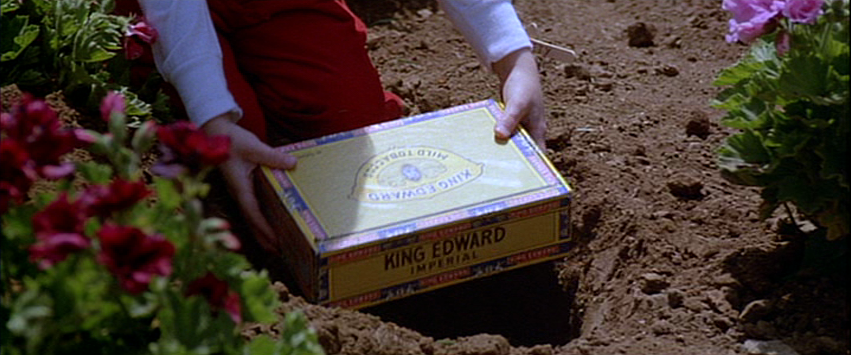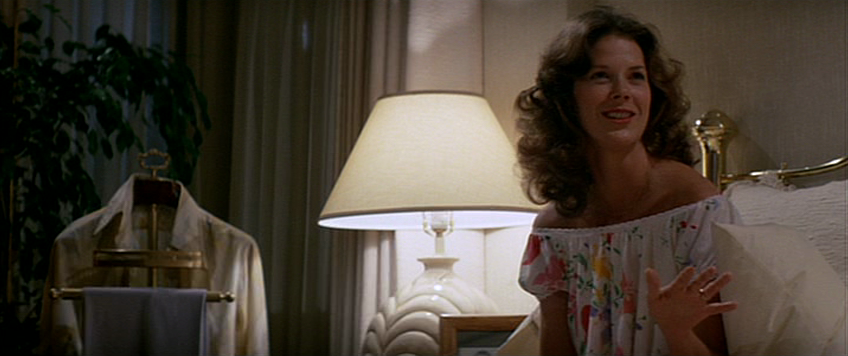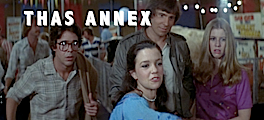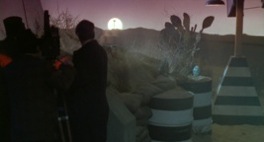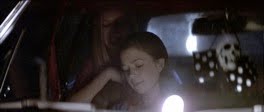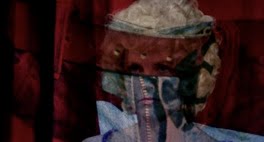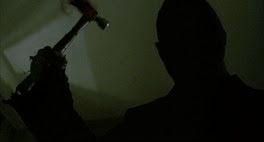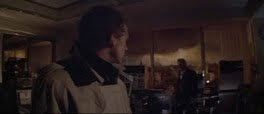"The genesis of it came from an article in The L.A. Times: When we were shooting the practical location on the house, the first two weeks of filming were exterior, so I had second-unit shots that had to be picked up in the front of the house. I was in the back of the house shooting Robbie [actor Oliver Robins] and the tree, looking down at the burial of the little tweety bird, so Steven was picking those shots up for me." - Tobe Hooper, AV Club interview, 2000
And a shot that was probably taken at a completely different time from the one previous to it, or any shot involving actors! Ah, the magic of cinema!

| EXT. FREELING'S YARD Sc: 20 (D2) 1/8 page Robbie in tree @ 2nd story window level; looks off to gathering storm. | 4 ROBBIE 1 S.I./Dbl. ATMOS: ? | SIMI VALLEY Welfare Wkr. Grip: parallels |
| **ILM SHOT** EXT. TREE - 16' ELEV. POV Sc: 20A (D2) 1/8 page Robbie's POV, storm clouds gather. | ATMOS: ? | SIMI VALLEY Grip: tie-down, parallels NOTE: SB#0-20A-1 |
Tweety's funeral I have spoken of before, but look at the still below and we see embossed the family in High Mannerist mode, an impromptu Madonna of the Rocks scene, religious art found in cinema, but further and extraordinarily in the everyday of Poltergeist's suburbia. Despite the family's composition evoking a piece of Renaissance statuary, the lack of (Spielbergian) chiaroscuro is important in this unpretentious domestic pietà, Hooper's more informal sensitivities moving Western religious iconography backwards from the High Mannerist paintings of Caravaggio and Da Vinci, back to the more plain-spoken pictorial reliefs of the Romanesque era: through the images is an instructive, multi-panel story of worship being told. Hooper's rarefied cinema of concepts and precise images guides us through a tiny story of worship through the length of this scene. Hooper's worship (of cinema) is less romantic, more practical, than his contemporaries, yet, as witnessed here, he is just as - actually more so - aware of the sacred image.
That's'a Hooper shot. ^^
That's'a Hooper shot. ^^
Hooper's interests in: 1) the architectural shot, 2) the morphological interrelationship of shots, 3) the POV shot as a studied aspect of this deliberate sense of cinematic grammar, and 4) the outwardly geometrical shot.
"Can I get a goldfish now?"
"Come and get it... Come and get it."
The shot we have below is an exquisite boon, a Tourneur-esque play of perspective, jumping to a detached viewpoint accompanied only by quietude, summative of a human or worldly variety (here a children's landscape), as in the human-filled traveling shots seen in I Walked With a Zombie and The Leopard Man. It is truly surprising in the context of the film, a bold image and maneuver staggered into the picture for us, emphasizing the deliberate beats of storytelling as priority over an obligatory rolling out of purely narrativized images.
Hooper, of course, is our master of shadows, despite my disavowal of chiaroscuro in the daylight pietà of the previous scene. Coppola may demand the deeper blacks, but Hooper has a stronger notion of the shadow as a concept and a physical phenomena to utilize, not with artistic pretense but with theoretical fascination. Known as the "strobe light" horror director, or the guy who creates "hallucinatory phantasmagorias" ever since he utilized the flash bulb in TCM, I sometimes balk at the characterization, as Hooper is actually always more about the experimental concept than he is about the stylistic results. Thus, Hooper's "light shows" carry an elementary quality that seem to barely hide their quaint nature as Hooper and his lighting crew manipulating film lights in very transparent (but inventive) ways, like old-fashioned illusionists. The shadow play above in this Poltergeist shot is a simple shadow puppet trick, Hooper finding it more beneficial to ground his horrors in a rhetoric of fantasy before allowing ILM to convince kids wholesale that their trees are out there to devour them. Later, the gimcrack strobing effect that emanates from the children's closet - when Tangina and the Freelings attempt to rescue Carol Anne from it - more effectively communicates the mimetic disjunction between the otherworldly and our worldly conception of it than any of the carefully (and convincingly) rendered light effects exhibited in Close Encounters or Raiders. Hooper's "strobes" were in utilization up to this point: the vampires coming in and out of darkness and a never-resting swinging lightbulb in Salem's Lot, the strobes and electrics of The Funhouse.
And what follows this point is a series of raw, elemental shots of terror atmospherics that recalls the child vampire scenes in Salem's Lot: an exaggeratedly-scaled window, gritty atmospherics like rolling fog and rain, and the tangible, artificial way in which these elements are lit.
Hooper's pageantry of the monster: the lightning drops the tree in and out of the darkness like a vaudeville spotlight, making no bones about revealing the irony of children's fears, especially as a representation in a piece of art. Childhood fears are artifice, twice removed from reality in their being filmed.

Robbie returns to his bed, ending a little cinematic unit called "Robbie Looks Out the Window." It is of complete imagistic self-service, its lacking of any sort of narrative impetus behind the images only allowing Hooper's emotional ideas of horror to emerge stronger. This sort of slackness with narrative images recalls the sequence of the funhouse puppets powering down in The Funhouse, or the shock cuts to the taxidermy animals of the Marsten House in Salem's Lot.
Hooper's musical touch is introduced with a clear extension of the earlier lateral tracking shot across the children's bedroom, here involving a forward push along with the mother Diane as she strides into the room. The previously-still camera (awaiting right outside the threshold of the children's bedroom) cascades forth with her intrusion, musicalizing the mother and her motion, just as the scene begins to stagnate with the children's stasis.
Spielberg is indeed capable of such musical instincts, such as the camera compassionately dollying in towards Melinda Dillon as elevator doors close on her in Close Encounters, but never with such collusion of grace and menace and observation as is seen in this doorway shot, where the composition is too precise an image of the threshold (a common motif for Hooper), the sensibility too clinical (exhibiting Hooper's trademark gift with the extreme wide lens), and the camera's movement too circuitous and complex, the menace emerging in the way the camera warps around the doorway to finally catch on Carol Anne doing mischief.

"Honey, you're overfeeding them!"
"Tweety 2 and Tweety 3 want seconds."
Also, notice how carefully Hooper has delineated the room, the earlier tracking shot showing one wall, the Diane shot revealing the other, denser and more boyish. It is these small surprises of rhetoric that add up to a greater cinema of rhetoric that belongs to Hooper.
The Alien poster revealed in this shot is also a rather snarky, censorious jab at our profligate intake of horror entertainments (an R-rated commercial smash naturally being allowed on the children's wall due to simply its being a cultural ubiquity), a fact somewhat regressive free of Hooper's summative, historical point-of-view regarding art and the genre.

"You know what happens when you overfeed goldfish?"
"They grow up... to be..."
"... sharks!"
"Goodnight."
While watching Poltergeist progress, it became clear what is distinctive about it: its lack of exposition, particularly in these opening 20 minutes, becoming almost a laconic thing due to its total make-up through "domestic vignettes" rather than any dramatic conflicts being genuinely introduced, or a slow establishment of character identification. Hooper realizes this aspect's full potential, drawing this opening act out, seeping it of the character-accessing zest I sense Spielberg might have brought to the picture if he had made it himself, effectively developing this family as real people we must get to know by genuinely spending time with them, without emotional projection (just yet), removed of any narrative (or sentimental) urgency.
(I always laugh at this... Clearly a hand in the frame waving the fish into motion...)

"Mom, there's a big storm headed this way."
"You'll be asleep by the time it gets here, if you hurry."
"Come on, in you go."
"In-ya-go."
"Goodnight, sweetie."
"Okay, light's out."
As mentioned before, the entire opening act of Poltergeist has been devoted to vignettes treated to Hooper's exquisite sense of distance. So, it is still a slightly denaturized experience to watch Diane perform as loving mother without having had much any access to her. It is not until the next scene - where she smokes dope and talks Freud with Craig T. Nelson - that, finally, the gears of plot stakes and character identification finally go into motion, if not through the camera, at least narratively. Until then, we have been witness to a slightly unreal portrait of daily routine in a suburban family. Thus, in this scene, with Hooper's distanciation techniques still in full force, our regard of Diane is still something of detached awe at this mysterious figure of perfect and poised maternal caring, lending this scene - filled with Hooper's cool, triangulating frames - a special, quiet force as its only purpose seems to be further embossing the image of the completely functioning family, not putting us in any hero's head.
"Closet light! Closet light!"
This is truly a remarkable shot, pinpointing Hooper's expertise in triangulating a space and characters' placements in that given space (not to mention further decrying the insidious presences of the Clown, the closet, and that damned Alien poster...).
"My fault. My fault."
Carol Anne: "Turn it on, Mommy!"
(... and a Darth Vader poster, Robbie's fascination with the character an amusing non sequitur.)
Good mother or bad mother? She cares, obviously, but what the heck is she thinking with that clown doll and enabling pop cultural fascination?
"That enough?"

"That enough? Okay?"
"Goodnight mom."
"Goodnight mommy."
Again we return to outside the threshold.

"Goodnight."

I am going to relinquish transcribing the film for the following scene, for there is way too much dialogue.
Spencer Tracy: "Either I'm dead or I'm crazy."
Other actor: "Well, you're not crazy, Pete."
Spencer Tracy: "You mean I'm dead?"
"Yeah!"
Tracy: "I'm... You mean, uh-- you mean this is for good?"
Other actor: "You guessed it!"(A scene from the film A Guy Named Joe. Yes, Spielberg remade it in 1989 as Always.)
Slow and low... a scene plays out over the course of a snail's-crawl tracking shot. A methodical approach to a scene less methodical, more about nothing.
If anything, it's about the parents finally together - smoking a doobie, peripherally discussing parent-things.
The camera moves along a careful, snaking curve, an itchy sort of movement more Hooper than anyone else, at least when presented so angularly slow.
Steven whips out a Reagan book as the camera comes around his front. Not in the Spielberg script, per se (who knows who came up with it, of course). What would you rather be reading, Reagan analysis or Man and His Symbols? Look forward and outward (politics and the future) or backward and inward (dreams and our psyche)? Are you a Steven or a Diane? One can say the two subjects are simply different forms of occultism - both hang our beliefs and projections of our selves on the unknown and unseeable.
This is a witty scene. The camera motion is a great part of this - though not the only part.
JoBeth Williams and Craig T. Nelson's performances and line deliveries skirt ever-so-tenuously the line of logic and making sense. Hooper definitely knows how to direct actors to act as if high (I'm sure he has some experience).
"Have you ever dove off a three-meter board, sweetheart?"
(Steven reacts strangely to - that is, he seems to have little concern at all about it - Diane's concern that Carol Anne's possible somnambulism poses the danger of her walking into the freshly-dug hole of the new pool. Pot makes him a jock bro, I guess.)
Diane: "What's three meters?"
Diane: "Well, listen, why don't we just dig the pool closer to the house and let the kids jump of the roof, you know?"
Good parents, bad parents. They can't be slavishly concerned about the well-being of their children all the time, right? You got to have some limit, especially when enjoying some weed. In the script, Diane's line above seems like it could actually be sarcasm-filled indignation. In the film, Williams delivers it as if the idea just might as well be the valid option if they are going to get the stupid pool in the first place.
A shot straight out of Lifeforce. The aggrandizement of the shadow cast by lampshades, as seen in Nurse Donaldson's room.
"... And---"
"--- splasshhhhh!"
Steven's jump is an interesting display of Hooper's penchant to delineate spaces very deliberately by sectioning them off into discrete spots, cut off from each other by restrictive, delimited frames, but connected by a subliminal establishment of geography and Hooper's strange sense of frame interrelation. This mirror was seen at the beginning of the slow tracking shot, elided soon after, then given this emphatic frame (after the completely de-locating low angle of Steven standing on the bed) for the express presentation of Steven's clowning.
"Before..."
"After..."
"Before... after..."
It is truly imaginative scene construction that keeps Poltergeist moving and involving us in it, even in its strange, mundane, almost plodding way of going about itself.





